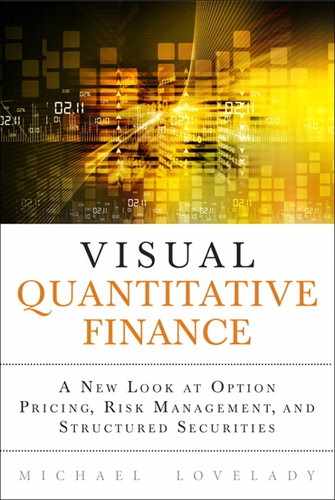Introduction to Chapters 14, “Tracking Performance,” and 15, “Covered Synthetic Annuities”
The final two chapters are supplemental material reprinted with permission from Pearson Education. These chapters originally appeared as Chapters 3 and 4 of Profiting with Synthetic Annuities: Options Strategies to Increase Yield and Control Portfolio Risk.
Profiting with Synthetic Annuities (PwSA) is about adding options to portfolios—not as trading instruments—but as integral components of investment positions. The goal of synthetic annuities is to create a hybrid architecture that balances the long-term investor perspective of traditional portfolios with the risk discipline of quantitative-based strategies.
Because synthetic annuities are designed and managed using quantitative models, I wanted to follow up in this book with an explanation of how the models are constructed. These final two chapters extend the conversation from the tools of quantitative finance to applied portfolio management. While this book defines the quantitative tools, PwSA is more of a practical guide for investors who are ready to begin building and managing structured securities.
My hope is that by seeing a practical application of the quantitative finance material in this book, the models and metrics will be more meaningful as you think about structured securities, synthetic annuities—or any other options strategy.
Chapter 14, “Tracking Performance,” introduces a trading platform (TradeStation) and a generalized template for tracking performance.
Chapter 15, “Covered Synthetic Annuities,” shows you how to build a conservative SynA and illustrates it with Deere & Company (NYSE: DE). A covered SynA is a form of SynA that uses only covered calls and protective puts. By nature, it is less volatile and less risky than its underlying security.
Option strategies such as the covered synthetic annuity that are restricted to covered calls and protective puts are well-suited to the retail investor market exactly because they are conservative. As a way to generate extra yield and create better risk profiles, these strategies are popular with many investors.
For example, BlackRock’s Michael Fredericks, head of retail asset allocation for the multi-asset group, talked about his group’s use of covered calls and protective puts in a CNBC interview.1 Options strategies have been a growing part of institutional allocations for many years, but it was interesting to see the level of enthusiasm from Fredericks and the panel with respect to the retail market, where options are often criticized as being too risky and too complex.
1 Michael Frederick interview: CNBC Half-Time Report, December, 2012 video link: http://www.cnbc.com/id/100335213/Go_RiskOn_in_2013_BlackRockrsquos_Fredericks
Fredericks: “We’re going to be more creative in where we find income. We’ve been selling covered calls...”
Fredericks said they prefer to sell 5% to 10% out-of-the-money calls, where the combination of the options premium and dividends on the underlying stocks are yielding around 9.5%. Compared to credit markets (which are subject to losses in rising interest rate environments) high-quality equities with options-enhanced yields are very attractive.
Fredericks: “You get upside and very competitive levels of yield. I don’t know where else you’re going to find that.”
In terms of risk management, he said that they are also taking advantage of low-volatility levels to buy protective puts on the S&P 500 index. BlackRock’s approach is consistent with the covered form of SynA described in Chapter 15.
As these strategies become more mainstream, there is, at the same time, the need for increased communication and education. At one level, investors and traders who manage their own portfolios will be looking for advice on how to use the information embedded in options prices and the options themselves to gain a trading edge, or create a comfortable investment style suited to them personally.
At a much broader level, institutional trustees and individual investors, who cannot by law or simply don’t want to manage portfolios, will still be influenced by industry trends. They will need to decide when and whether to participate in customized solutions or offerings from investment firms or “smart ETF” providers. The issue for them will be to understand enough to make smart choices.
As an example of new fund offerings, a few years ago the Wisdom Funds launched a family of funds based on the investment theme of dividends and the importance of dividends to total returns over the long term. Rather than weighting an index by stock market capitalization, they use a weighting system related to dividends.
Going forward, it is logical to imagine that many investment management firms and ETF providers will launch new funds based on an options theme. As discussed in this book, options create a new source of return related to time decay and measured by theta. In the next two chapters, theta is translated into projected payback periods. Accelerating payback periods while reducing volatility are part of the design goals of synthetic annuities.
Because of the potential advantages, it is easy to justify the rationale behind an options theme. It is harder to identify exactly what that means. Options themes are very broad and include an incredible array of possibilities. They can be conservative by nature, such as the covered varieties, or extremely aggressive, leveraging capital and market exposure. They can be applied to an entire portfolio or only to specific parts of it. Some option strategies will be right for some, and probably many, investors. It is just a matter of matching strategy style with investor preference—something that has not and will not change.
